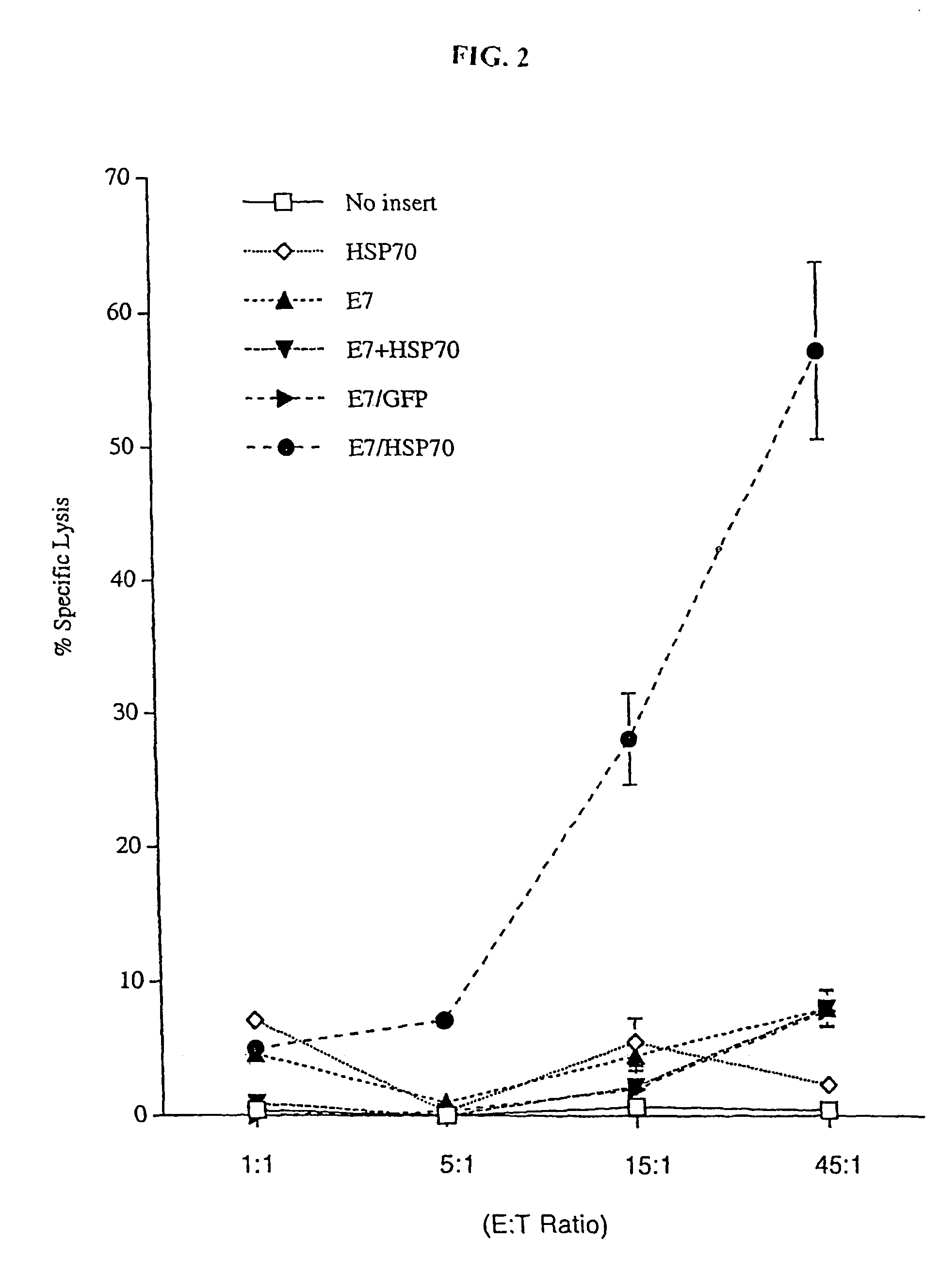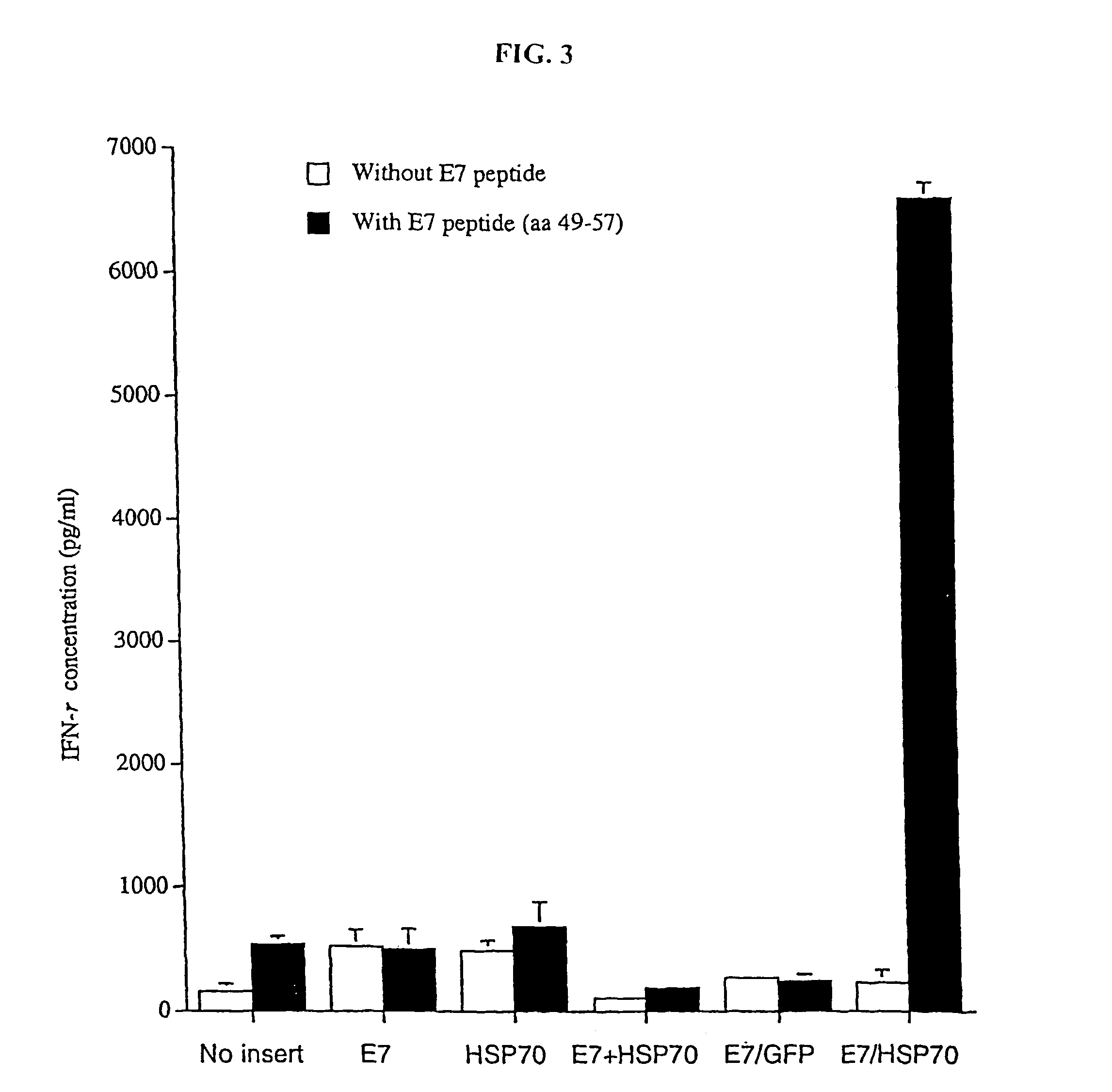Superior molecular vaccine based on self-replicating RNA, suicidal DNA or naked DNA vector, that links antigen with polypeptide that promotes antigen presentation
a dna vaccine and self-replicating technology, applied in the field of molecular biology, can solve the problems of limited potency of dna vaccines, and achieve the effect of greater e7-specific t cell-mediated immunity
- Summary
- Abstract
- Description
- Claims
- Application Information
AI Technical Summary
Benefits of technology
Problems solved by technology
Method used
Image
Examples
example i
Enhancement of Sindbis Virus Self-Replicating RNA Vaccine Potency by Linkage of Nucleic Acid encoding Mycobacterium Tuberculosis
Heat Shock Protein 70 and an Antigen
[0202]The present study investigated whether DNA linking full-length E7 to Hsp70 can enhance the potency of self-replicating Sindbis RNA vaccines. We showed that a Sindbis RNA vaccine linking E7 with Hsp70 significantly increased expansion and activation of E7-specific CD8+ T cells and NK cells, bypassing the requirement for CD4+ T cell-mediated help and resulting in potent anti-tumor immunity against E7-expressing tumors. Mechanistic studies confirmed that the Sindbis E7 / Hsp70 RNA vaccine induced apoptotic death of host cells and promoted processing of this apoptotic material by dendritic cells (DCs), leading to significantly increased expansion and activation of E7-specific CD8+ T cells. This enhanced CD8 response resulted in a state of potent anti-tumor immunity against an E7-expressing tumor cell line.
[0203]Materials...
example ii
Enhancement of Suicidal DNA Vaccine Potency by Linking Mycobacterium Tuberculosis Heat Shock Protein 70 to an Antigen
[0238]Recently, RNA replicon vaccines have emerged as an important strategy to alleviate the concerns for potential chromosomal integration and cell transformation noted above (Ying et al., supra). These vaccines are self-replicating, self-limiting and may be administered either as RNA or as DNA which is then transcribed into RNA replicons in transfected cells in vitro or in vivo. DNA-based self-replicating RNA replicons, also known as “suicidal DNA,” eventually cause lysis of transfected cells(Berglund et al., supra; Leitner et al., supra).
[0239]The present vaccine was developed using the Semliki Forest virus suicidal DNA vector, pSCA1 (DiCiommo, D P et al., J Biol Chem 1998; 273:18060-6). Such vectors alleviate some concern about naked DNA because they eventually cause apoptosis of transfected cells. This feature is particularly desirable for vaccines that encode po...
example iii
Enhancement of DNA Vaccine Potency by Linking DNA Encoding Antigen to DNA Encoding the Extracellular Domain of Flt3-Ligand
[0265]Prior to the present invention, To date, FL had not been used as part of a chimeric DNA vaccine. The present inventors and their colleagues investigated whether linking a full-length E7 DNA to DNA encoding the ECD of FL would enhance the potency of a DNA vaccine. They chose HPV-16 E7 as a model antigen for vaccine development (see above).
[0266]Studies were done to compare DNA vaccines containing wild-type E7 with DNA vaccines containing full-length E7 fused to FL for their stimulation of immune responses and their ability to protect animals against growth or metastasis of E7-expressing tumors (Lin et al., supra). The results presented below indicate that linking DNA encoding the ECD of FL to E7 dramatically increased the expansion and activation of E7-specific CD8+ T cells, completely bypassing the CD4 arm. This strategy led not only to enhanced E7-specific...
PUM
| Property | Measurement | Unit |
|---|---|---|
| length | aaaaa | aaaaa |
| nucleic acid | aaaaa | aaaaa |
Abstract
Description
Claims
Application Information
 Login to View More
Login to View More - R&D
- Intellectual Property
- Life Sciences
- Materials
- Tech Scout
- Unparalleled Data Quality
- Higher Quality Content
- 60% Fewer Hallucinations
Browse by: Latest US Patents, China's latest patents, Technical Efficacy Thesaurus, Application Domain, Technology Topic, Popular Technical Reports.
© 2025 PatSnap. All rights reserved.Legal|Privacy policy|Modern Slavery Act Transparency Statement|Sitemap|About US| Contact US: help@patsnap.com



